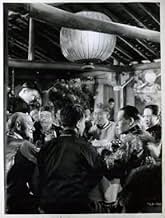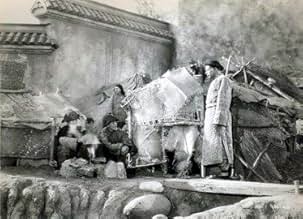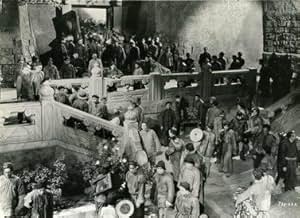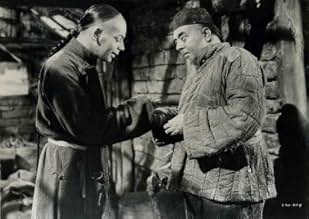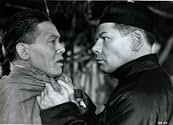Agrega una trama en tu idiomaAlthough married Chinese farmers Wang and O-Lan initially experience success, their lives are complicated by declining fortunes and lean times, as well as the arrival of the beautiful young ... Leer todoAlthough married Chinese farmers Wang and O-Lan initially experience success, their lives are complicated by declining fortunes and lean times, as well as the arrival of the beautiful young Lotus.Although married Chinese farmers Wang and O-Lan initially experience success, their lives are complicated by declining fortunes and lean times, as well as the arrival of the beautiful young Lotus.
- Ganó 2 premios Óscar
- 7 premios ganados y 3 nominaciones en total
- Revolutionary Army Captain
- (sin créditos)
- Man
- (sin créditos)
- Teahouse Dancer
- (sin créditos)
- Chinese Girl
- (sin créditos)
Opiniones destacadas
I was particularly impressed by the camera work and the use of crowd scenes, especially during the sacking of the palace where O-Lan was once a slave. The graphic and grim atmosphere of the firing squad and the drought made this an epic quite unlike others of the same time where it was all glitz and glitter. I watched this film from beginning to end enthralled. I can't say the same for the "epics" of today.
Luise Rainer was the beautiful star who had won the Best Actress Oscar the year before for her small role (and what a waste of an oscar) in "The Great Zigfield". It really didn't show what, if any, talent she had other than her exotic beauty. But in "Good Earth" she shows that she can really act! Her beauty was erased and she had no great costumes either. People say that she didn't show any real emotions in this film. Like hell. Her character Olan is a shy and timid woman, with inner strength. She is quiet during parts of the film with only her eyes and body to convey her emotions. Example: those scenes during the fall of the city and when looters were being shot. If you people are saying that she doesn't act well in this film, you are NOT looking!
Paul Muni shows that he can act as well. His character is not a likeable one to me. He never sees her for what she is, until the very end of the story. A sweet loving and dedicated wife and mother, with her own special beauty. The greatest one of all, the beauty from within, like a pearl.
If you get a chance to see this film, watch it. You will see one of the best films that the golden age of Hollywood created.
From the very beginning of the picture, right after the lion's roar, we see the poignant tribute to Irving Thalberg, and we know that we are embarking on an important viewing experience. The scope of the story is very wide, and the filmmakers are up for the task. I was always struck by the abruptness of the final scene, but its power and beauty form an excellent example of the art achieved within the often cynical Hollywood film factory. And Lotus - the strangeness of her, and her dance, contrasted with the goodness of O-lan!
Aside from the oft-mentioned attributes of acting, photography and special effects, a major element in 'The Good Earth' is the score. Herbert Stothart may not be in the ranks of Hollywood's 'mighty handful' (Alfred Newman, Steiner, Tiomkin, Waxman, Herrmann), but his 'MGM-sound' scores regularly deliver the goods. True, Stothart had no hesitation in applying the syrup at first opportunity (one can imagine Louis B. Mayer positively ordering it), but in this picture, syrup gives way to sympathy. One of the pleasures of Hollywood's Golden Age films is that all the elements of a given film support each other, and great scores support not only the characters, but the entire film. Stothart's score is so sympathetic and so sincere, from the Main Title all the way through, and it enhances the story and the performances so naturally and at times transparently, that it must be considered a classic score. No great 'tunes' specifically, but plenty of effective mood, atmosphere and unabashed emotion. Many of today's audiences may find little to enjoy in such a combination, or they may be embarrassed by it, but I revel in it, as cinema such as this, which is delivered with such heart and good will is, especially in these times, nothing short of a gift.
The issue of non-Chinese playing Chinese characters has already been discussed on these pages, but I can only add: please, viewers, consider the film within the era that it was produced. The same kind of incongruity still happens today, perhaps not so much racially, but certainly culturally: Brad Pitt in 'Seven Years in Tibet', Keanu Reeves in 'Little Buddha', and other Americans getting plum roles in British-originated stories that become Hollywoodized, etc. When making 'Bhowani Junction', George Cukor considered using Indian actors, but vetoed any candidates in favor of familiar Hollywood faces. Never mind that in the 50s, as today, India had a huge film industry. It's just that those actors didn't fit into the Hollywood scheme of things. That speaks of box office more than political incorrectness. There is no doubt that fine actors like Philip Ahn should have gotten lead roles in pictures like 'The Good Earth', but at least we can enjoy them in supporting roles which carry a lot of weight in their own right. As time goes on, the context of past eras fades, while the films themselves, the really good ones, live on. There's plenty of opportunity for revisionist theses about issues like racial inequality in 1930s Hollywood, but for 138 minutes, it is compelling and moving to absorb onesself in the story and the atmosphere of 'The Good Earth'.
This was the first movie I saw at New York's Museum of Modern Art, around 1970 (I was a teenager). Expensive looking yet with scenes of such poverty, masterfully photographed, often thrilling, and always engaging, to me it was MGM movie-making at its best. What did audiences feel when they glimpsed a locust attack, the person by person destruction of a mansion, the horrific poverty and then the splendor of wealth.
Last week, those watching the Academy Awards had a glimpse of the "senior" Oscar winner in attendance, Luise Rainer. How grand to see an actress who arguably delivered one of the most masterful, haunting performances in history electing to return for a celebration.
Ok, so she should not have won the year before (Great Ziegfeld), but don't blame Luise. Talkies were only a decade old when this was released, and her dialogue limited. But as Olan, her use of visual and vocal is memorable.
Large scale and touching, what more could a movie lover want!
Perhaps it's partly because the story was written by a westerner, Pearl Buck who got a Pulitzer Prize for her novel in 1932. Ms. Buck, daughter of Chinese missionaries, probably brought China closer to the consciousness of America than any other person. Not the political struggles of China, but the lives and toil of the every day people we find in The Good Earth. Unfortunately later on, Pearl Buck became an apologist for the Kuomintang China of Chiang Kai-Shek in all its virtues and excesses. The rest of her literary output never matched The Good Earth.
In The Sundowners there is a great description of comparing China to Australia by Peter Ustinov. When asked the difference, Ustinov said China was very big and very full and Australia was very big and very empty. That's what you see in The Good Earth, China very big and very full of people, more than she can deal with at times.
The Good Earth tells the story of Wang Lung (Paul Muni) as a young man who purchases a wife from a large house where she was a slave. The woman O-Lan (Luise Rainer) bears him two sons and sees him through all the good times and bad they have, drought, famine, revolution, and a climatic locust plague.
Luise Rainer won the second of two consecutive Oscars for portraying O-Lan. She may have set some kind of record in that it has to be the leading player Oscar performance with the least amount of dialog. Everything she does practically is done with facial expressions, her performance could have been on a silent film with very minimal subtitles. I think only John Mills in Ryan's Daughter had fewer words and he was playing a mentally retarded man.
Muni is not always appreciative of how supportive she is in that male dominated culture. Rainer helps in the field, bears and raises the kids, does the housework. When Muni becomes a man of property he takes a Chinese second trophy wife who causes him a lot of grief. Still Rainer stoically bears it all. Still Muni is not a bad man and it's a tribute to the film and his acting and Buck's writing that you don't hate him and the culture gap is bridged.
We've got a group of oriental players now who do more than just Kung Fu movies. I'm surprised The Good Earth of all films has not been remade at this point. I'll bet the Chinese government would even let some American company do it on an actual location.
Till then we've got this great classic to appreciate and enjoy.
¿Sabías que…?
- TriviaSpecial effects experts were unable to produce an authentic-looking locust plague. Just as they were about to abandon the scene, they received word that a real locust plague was taking place several states away. A camera crew was rushed to the scene to capture it on film.
- Errores(at around 2h 5 mins) Wang Lung is walking through the locust storm in his wheat field. He picks up a few men who have fallen down into the thick pile of locusts. In frustration, Wang shouts "I said save the wheat! Save it!" At this moment, a man dressed in 1937-era American clothing walks across the scene from left to right, at the top third of the screen. He is wearing a white hat and appears to be smoking a cigarette or cigar held in his left hand.
- Citas
Wang Lung: [must sell his land to feed his family but the buyers take advantage of him] Thieves! Thieves! And well you know I must sell.
O-Lan: No! Not the land. We'll not sell the land. We'll keep it. We'll go south and when we return, we'll still have the land.
Uncle: But I've arranged it. I brought these men here. You MUST sell!
O-Lan: Is it your land? Did you buy it bit by bit? The land is our life... and it's better to go south... or die walking... than to give it to you for nothing.
- Créditos curiososIntroduction played with opening credits: The soul of great nation is expressed in the life of its humblest people. In this simple story of a Chinese farmer may be found something of a the soul of China - its humility, its courage, its deep heritage from the past and its vast promise for the future.
- ConexionesEdited into La estirpe del dragón (1944)
Selecciones populares
Detalles
- Fecha de lanzamiento
- País de origen
- Sitio oficial
- Idioma
- También se conoce como
- The Good Earth
- Locaciones de filmación
- Cedar City, Utah, Estados Unidos(backgrounds for locust sequence)
- Productora
- Ver más créditos de la compañía en IMDbPro
Taquilla
- Presupuesto
- USD 2,800,000 (estimado)
- Tiempo de ejecución2 horas 18 minutos
- Relación de aspecto
- 1.37 : 1
Contribuir a esta página




